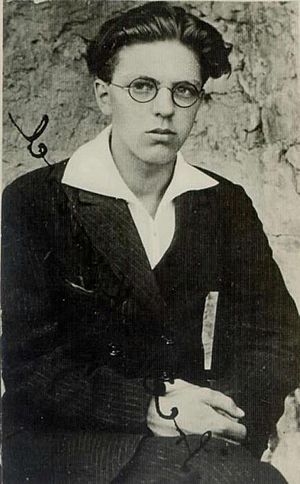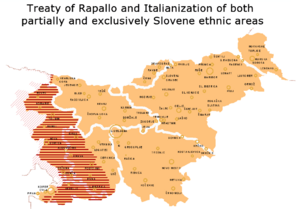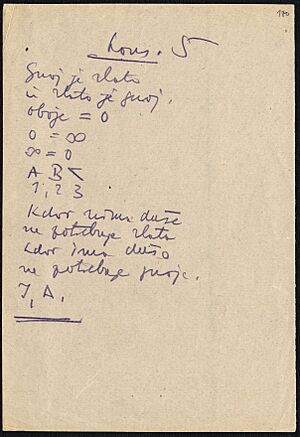Srečko Kosovel facts for kids
Quick facts for kids
Srečko Kosovel
|
|
|---|---|
 |
|
| Born | March 18, 1904 Sežana, Gorizia and Gradisca, Austria-Hungary (now in Slovenia) |
| Died | May 26, 1926 (aged 22) Tomaj, Kingdom of Italy (now in Slovenia) |
| Occupation | Poet |
| Literary movement | Impressionism, Expressionism, Constructivism |
| Notable works | Konsi |
Srečko Kosovel (18 March 1904 – 26 May 1926) was an important Slovenian poet. Many people today consider him one of the most significant modern poets in Central Europe. He was known for writing about his home region, the Karst Plateau. He also wrote about politics, speaking out against the forced use of the Italian language in Slovene areas taken over by Italy.
Kosovel used many different styles in his poetry. These included Impressionism, Expressionism, and Constructivism. He also used avant-garde forms, which means he tried new and experimental ways of writing. Even though he died very young, at just 22, he is now seen as a true icon of Slovenian poetry.
Most of Kosovel's poems were published nearly 40 years after he passed away. In Slovenia, he is remembered as a poet who created a huge amount of work. He left behind over 1000 drafts, with 500 complete poems. People think his writing was incredibly good for someone so young.
Contents
Life of Srečko Kosovel
Srečko Kosovel was the youngest of five children. His father, Anton Kosovel, was a Slovene teacher. However, he was not allowed to teach in the Slovene language after his region became part of Italy. Srečko's mother, Katarina, was 40 when he was born. She encouraged the artistic talents of all her children. Srečko's sister played the piano, and one of his brothers wanted to be a writer.
Srečko was born in Sežana, which was then part of the Austro-Hungarian Empire. He lived in the nearby village of Tomaj until 1924. Before his home region was taken over by Italy, he learned a lot about Slovene culture. He especially loved Slovene literature and plays at the Slovene theatre in Trieste.
War and its impact
Kosovel's life was deeply affected by war. He has been compared to the French poet Arthur Rimbaud. Both poets were very young when they saw the suffering caused by war. The Battles of the Isonzo were a series of terrible fights during World War I. These battles started when Kosovel was 12 and ended when he was 17. They took place very close to his village.
Kosovel often saw wounded soldiers and dead bodies. This was because the battlefield was only about 15 kilometers from his home. These experiences were very upsetting for him. To keep him safe from the war, his parents sent him and his sister to Ljubljana in 1916. He stayed there until he died.
Changes after the war
After World War I, the Treaty of Rapallo meant that Slovene lands, including Kosovel's home, became part of Italy. This was a very sad time for Kosovel. The new Fascist government in Italy banned all Slovene schools and organizations. Slovene thinkers and writers faced harsh treatment. This made Kosovel feel like he had lost his beloved homeland. It caused him great sadness, anger, and confusion.
To make things worse, his new country, the Kingdom of Yugoslavia, did not seem to care about the Slovenes suffering under Italian rule. This made Kosovel become more interested in radical politics and art. He even had connections with a group called TIGR, which fought against the Fascist government.
In 1926, Kosovel went to the town of Zagorje to give a poetry reading. While waiting for his train back to Ljubljana, he caught a cold. This cold turned into a serious brain infection called meningitis. He returned to his home village of Tomaj and died on May 26, 1926.
Kosovel's Work
Kosovel's early poems often expressed his feelings of missing his family and his beautiful Karst homeland. When he went to the University of Ljubljana, he met other Slovenes who had left areas taken by Italy. Together, they started a literary magazine called Lepa Vida ("The Fair Vida"). Kosovel became the editor of this magazine.
At the "Ivan Cankar Club," named after a famous Slovenian writer, Kosovel learned about more radical ideas. He became very interested in revolutionary thoughts and new, experimental works from the Soviet Union and Germany.
The Constructivist Style
In 1925, Kosovel worked with an artist named Avgust Černigoj. They thought about starting a new magazine called Konstruktor ("Constructor"). Around this time, Kosovel began writing his "constructivist" poems, which he called konsi (short for "constructions").
With constructivism, he changed his quiet, lyrical style to a loud, bold, and challenging poetry. He experimented with language, using no strict grammar or logic. He played with images, different fonts, styles, and colors. He even used mathematical symbols, equations, and paper collages in his writing.
At the same time, Kosovel wanted to publish a collection of his early poems called Zlati čoln ("Golden Boat"). He hoped this book would mark the end of his early, more traditional style. However, both publishers and his friends did not like the poems, which upset him greatly.
After this, Kosovel focused only on his constructivist poetry. He wanted to publish these poems in a collection called Konsi. But he never managed to do it during his lifetime. His constructivist poems remained unknown to the public until 1967. That's when Anton Ocvirk finally published them in a collection called Integrali '26.
In 1925, Kosovel also became the editor of the magazine Mladina (Youth). This was a huge step for him. He had big plans for the magazine. He wanted to make it a national publication for left-wing ideas. He hoped it would attract all modern and experimental artists from Slovenia and Yugoslavia. He also wanted it to be a platform for radical Slovenian political ideas. He continued to edit the magazine until his death.
Later Works and Ideas
The year 1925 was Kosovel's most creative period. It was also when his political views shifted more to the left. His writing style became simpler, so it could reach more ordinary people. Kosovel had an idea for a writers' union for working-class people. He also dreamed of a publishing house called Strelci ("Archers"). He hoped his collection of constructivist poems could be published there.
See also
 In Spanish: Srečko Kosovel para niños
In Spanish: Srečko Kosovel para niños




